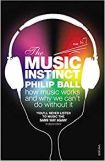The Music Instinct: How Music Works and Why We Can't Do without it by Philip Ball
| The Music Instinct: How Music Works and Why We Can't Do without it by Philip Ball | |
|
| |
| Category: Popular Science | |
| Reviewer: Paul Harrop | |
| Summary: A valuable and serious survey of current thinking about music's structures and how they relate to our cognitive functions. An occasionally challenging but refreshingly unstuffy approach to a universal human pursuit. | |
| Buy? Yes | Borrow? Yes |
| Pages: 464 | Date: February 2010 |
| Publisher: The Bodley Head Ltd | |
| ISBN: 978-1847920881 | |
|
| |
We need to talk about music, but it is hard. Very few people can do it. So says Philip Ball after 400 pages of talking about music. Very few readers who make it that far will disagree with his conclusion, but most will have gained some enlightenment about how music works and why we enjoy it.
At the other end of his book he starts with a quote from cognitive scientist Steven Pinker who airily dismisses music as ephemeral confectionary for the mind. And Ball's whole thesis could be seen as a rebuttal of Pinker's stance, trying to do for music what Pinker does for language, even cheekily mimicking the title of Pinker's The Language Instinct. The problem with that approach, as we soon learn, is that the ability to appreciate, let alone play music, is not innate in that same way that language clearly is. We have evolved hard-wired ability to acquire and use language, because such communication skills conferred an evolutionary advantage. Music is, Ball finds, a skill we have to learn just as language is, but we probably didn't need to be able to carry a tune to escape a sabre-toothed tiger.
Rather he shows us, in the most fascinating parts of this book, that music, as an almost universal human activity, uses parts of the brain that have evolved for other reasons - those which recognise and anticipate patterns of external events for instance. The fact that, as he reveals, music uses many different parts of the brain, goes some way to explaining its unique status as a pure art form.
Music, he shows, does not have to rely on any mimetic or narrative function to mean something to us. In fact, its meaning and what it communicates are probably never going to be explained in words, or even by sophisticated neural analysis. Like many of the workings of the brain, it remains mysterious. And therein, I suspect, lies part of its appeal.
To make many of these points Ball has to establish basic terms of reference and means of expression. This entails setting out what, for me, are terrifyingly opaque mathematical matters such as harmonic theory, scales and musical notation.
And although you can hear many of his examples on a dedicated website, he still assumes that readers will be able to understand the printed segments of musical notation throughout the text. For me, despite and maybe because of, my vain attempts to master musical instruments, they are as forbidding as hieroglyphics. I kept thinking how much more suited his subject matter would be to an illustrated lecture series than to the printed page.
I also struggled with some of the complexities of the musicological and cognitive science which he surveys. Generally he manages to convey the essence of their findings in layperson's terms, but that's not to say that the book doesn't have some challenging passages.
While the scientific and musical theories used in the book were occasionally fearsome, I was heartened by Ball's refreshingly inclusive and iconoclastic choice of musical references. He is as likely to cite the Beatles as Beethoven, and Led Zeppelin get more mentions than Liszt. He readily admits that popular music is harmonically and structurally cruder than most classical forms. But he is not afraid to draw parallels between them, and to explore rock music's particular strengths - chiefly a matter of timbre and performance, it seems. And that's without really touching on the social roles which, especially in popular and ritual music, are arguably as important as their aesthetic appeal.
Likewise, the success of this book lies in its author's clear love of music in all its facets: in his ability to be fascinated by the mechanics of its form and function, without losing sight of its essentially emotional impact. As a bridge between those of us who love music and those who know why we love it, it is a serious and valuable piece of work.
I'd like to thank the publishers for sending a copy to The Bookbag.
If this book appeals to you then you might also enjoy The Language Instinct: The New Science of Language and Mind by Steven Pinker.
Please share on: ![]() Facebook,
Facebook, ![]() Twitter and
Twitter and
![]() Instagram
Instagram
![]() You can read more book reviews or buy The Music Instinct: How Music Works and Why We Can't Do without it by Philip Ball at Amazon.co.uk Amazon currently charges £2.99 for standard delivery for orders under £20, over which delivery is free.
You can read more book reviews or buy The Music Instinct: How Music Works and Why We Can't Do without it by Philip Ball at Amazon.co.uk Amazon currently charges £2.99 for standard delivery for orders under £20, over which delivery is free.
![]() You can read more book reviews or buy The Music Instinct: How Music Works and Why We Can't Do without it by Philip Ball at Amazon.com.
You can read more book reviews or buy The Music Instinct: How Music Works and Why We Can't Do without it by Philip Ball at Amazon.com.
Comments
Like to comment on this review?
Just send us an email and we'll put the best up on the site.


